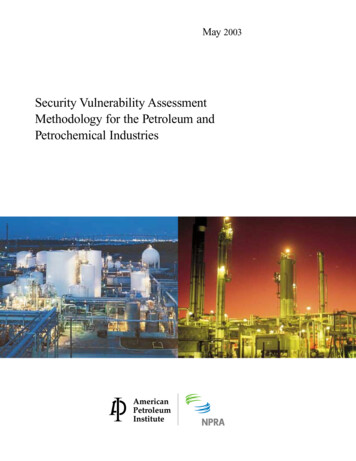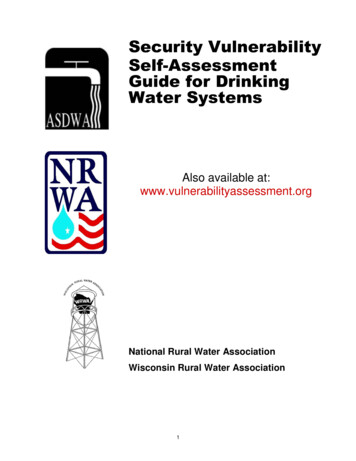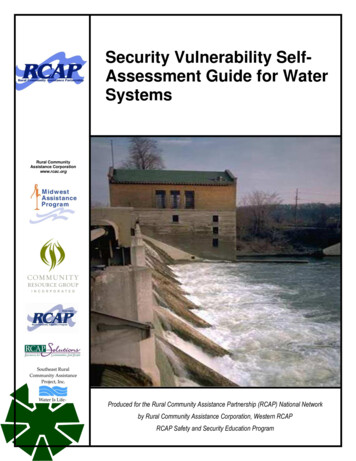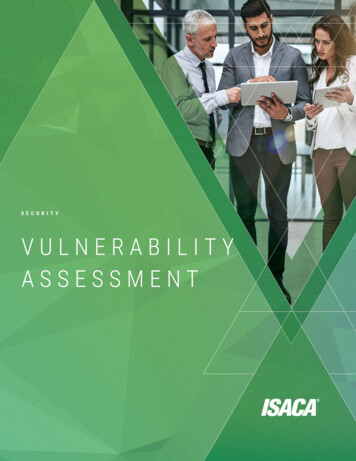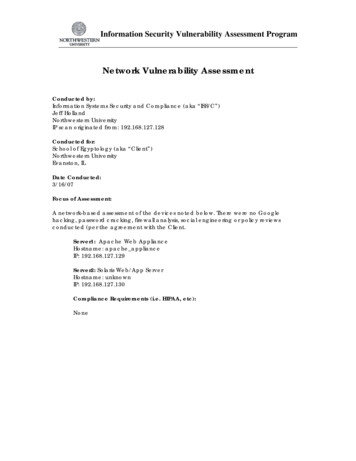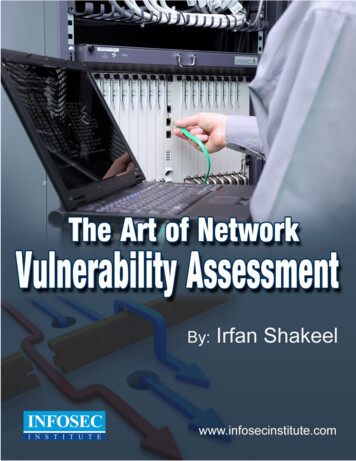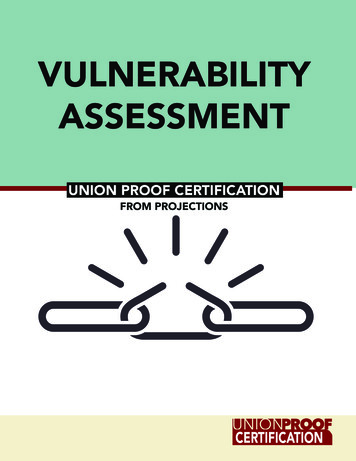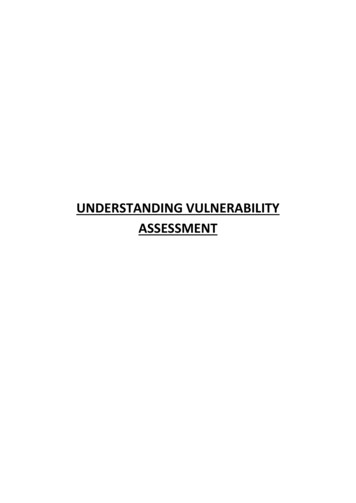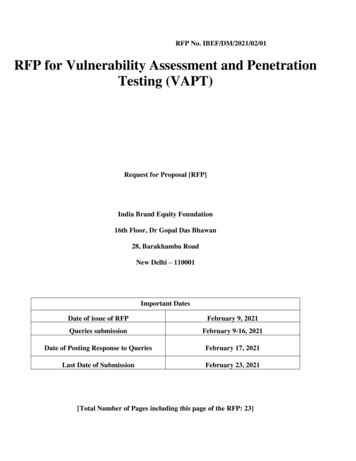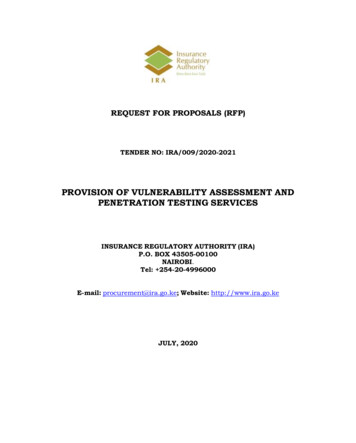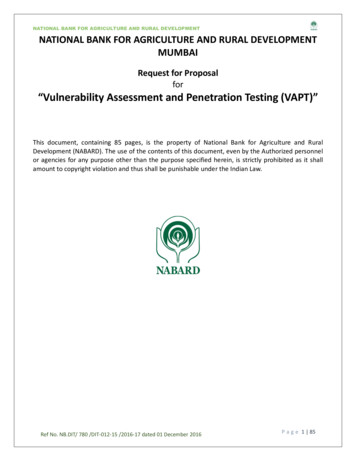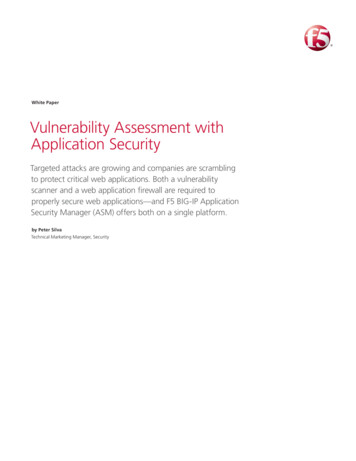
Transcription
White PaperVulnerability Assessment withApplication SecurityTargeted attacks are growing and companies are scramblingto protect critical web applications. Both a vulnerabilityscanner and a web application firewall are required toproperly secure web applications—and F5 BIG-IP ApplicationSecurity Manager (ASM) offers both on a single platform.by Peter SilvaTechnical Marketing Manager, Security
White PaperVulnerability Assessment with Application SecurityIntroduction3Web Security Challenges3Application Vulnerability ScannersIntegration Reduces Risk45BIG-IP Application Security Manager5IBM Security AppScan Scanner6Cenzic Hailstorm Scanner6QualysGuard WAS6WhiteHat Sentinel7Improved Web Application Visibility8Additional Enhancements in BIG-IP ASM8Conclusion92
White PaperVulnerability Assessment with Application SecurityIntroductionProtecting web applications is an around-the-clock job. Almost anything that isconnected to the Internet is a target these days, and organizations are scramblingto keep their web properties available and secure. The ramifications of a breachor downtime can be severe: brand reputation, the ability to meet regulatoryrequirements, and revenue are all on the line. A 2011 survey conducted by MerrillResearch on behalf of Verisign found that 60 percent of respondents rely on theirwebsites for at least 25 percent of their annual revenue.1And the threat landscape is only getting worse. Targeted attacks are designed togather intelligence; steal trade secrets, sensitive customer information, or intellectualproperty; disrupt operations; or even destroy critical infrastructure. Targeted attackshave been around for a number of years, but 2011 brought a whole new meaningto advanced persistent threat. Symantec reported that the number of targetedattacks increased almost four-fold from January 2011 to November 2011.2In the past, the typical profile of a target organization was a large, well-known,multinational company in the public, financial, government, pharmaceutical, orutility sector. Today, the scope has widened to include almost any size organizationfrom any industry. The attacks are also layered in that the malicious hackers attemptto penetrate both the network and application layers.To defend against targeted attacks, organizations can deploy a scanner to check webapplications for vulnerabilities such as SQL injection, cross site scripting (XSS), andforceful browsing; or they can use a web application firewall (WAF) to protect againstthese vulnerabilities. However a better, more complete solution is to deploy both ascanner and a WAF. F5 BIG-IP Application Security Manager (ASM) version is aWAF that gives organizations the tools they need to easily manage and secure webapplication vulnerabilities with multiple web vulnerability scanner integrations.Web Security ChallengesAs enterprises continue to deploy web applications, network and security architectsneed visibility into who is attacking those applications, as well as a big-picture viewof all violations to plan future attack mitigation. Administrators must be able to1 http://www.verisigninc.com/en US/forms/ddosattentionreport.xhtml?loc en US?cmp tw2 NT 2011 11 November FINAL-en.pdf3
White PaperVulnerability Assessment with Application Securityunderstand what they see to determine whether a request is valid or an attack thatrequires application protection. Administrators must also troubleshoot applicationperformance and capacity issues, which proves the need for detailed statistics. Withthe increase in application deployments and the resulting vulnerabilities, administratorsneed a proven multi-vulnerability assessment and application security solution formaximum coverage and attack protection. But as many companies also supportgeographically diverse application users, they must be able to define who is grantedor denied application access based on geolocation information.Application Vulnerability ScannersTo assess a web application’s vulnerability, most organizations turn to a vulnerabilityscanner. The scanning schedule might depend on a change control, like when anapplication is initially being deployed, or other factors like a quarterly report. Thevulnerability scanner scours the web application, and in some cases actuallyattempts potential hacks to generate a report indicating all possible vulnerabilities.This gives the administrator managing the web security devices a clear view of allthe exposed areas and potential threats to the website. It is a moment-in-time reportand might not give full application coverage, but the assessment should giveadministrators a clear picture of their web application security posture. It includesinformation about coding errors, weak authentication mechanisms, fields orparameters that query the database directly, or other vulnerabilities that provideunauthorized access to information, sensitive or not. Many of these vulnerabilitieswould need to be manually re-coded or manually added to the WAF policy—bothexpensive undertakings.Another challenge is that every web application is different. Some are developed in.NET, some in PHP or PERL. Some scanners execute better on different developmentplatforms, so it’s important for organizations to select the right one. Somecompanies may need a PCI DSS report for an auditor, some for targeted penetrationtesting, and some for WAF tuning. These factors can also play a role in determiningthe right vulnerability scanner for an organization. Ease of use, target specifics, andautomated testing are the baselines. Once an organization has considered all thosedetails, the job is still only half done.Simply having the vulnerability report, while beneficial, doesn’t mean a web appis secure. The real value of the report lies in how it enables an organization todetermine the risk level and how best to mitigate the risk. Since re-coding anapplication is expensive and time-consuming, and may generate even more errors,many organizations deploy a web application firewall like BIG-IP ASM. A WAF4
White PaperVulnerability Assessment with Application Securityenables an organization to protect its web applications by virtually patching theopen vulnerabilities until it has an opportunity to properly close the hole. Often,organizations use the vulnerability scanner report to then either tighten or initiallygenerate a WAF policy.Attackers can come from anywhere, so organizations need to quickly mitigatevulnerabilities before they become threats. They need a quick, easy, effective solutionfor creating security policies. Although it’s preferable to have multiple scanners orscanning services, many companies only have one, which significantly impedes theirability to get a full vulnerability assessment. Further, if an organization’s WAF andscanner aren’t integrated, neither is its view of vulnerabilities, as a non-integratedWAF UI displays no scanner data. Integration enables organizations both to managethe vulnerability scanner results and to modify the WAF policy to protect against thescanner’s findings—all in one UI.Integration Reduces RiskWhile finding vulnerabilities helps organizations understand their exposure, theymust also have the ability to quickly mitigate found vulnerabilities to greatly reducethe risk of application exploits. The longer an application remains vulnerable, themore likely it is to be compromised.BIG-IP Application Security ManagerF5 BIG-IP ASM, a flexible web application firewall, enables strong visibility withgranular, session-based enforcement and reporting; grouped violations forcorrelation; and a quick view into valid and attack requests. BIG-IP ASM deliverscomprehensive vulnerability assessment and application protection that can quicklyreduce web threats with easy geolocation-based blocking—greatly improving thesecurity posture of an organization’s critical infrastructure.BIG-IP ASM (version 11.1 and later) includes integration with IBM Security AppScan,Cenzic Hailstorm, QualysGuard WAS, and WhiteHat Sentinel, building more integrityinto the policy lifecycle and making it the most advanced vulnerability assessmentand application protection on the market. In addition, administrators can bettercreate and enforce policies with information about attack patterns from a groupingof violations or otherwise correlated incidents. In this way, BIG-IP ASM enables5
White PaperVulnerability Assessment with Application Securityorganizations to mitigate threats in a timely manner and greatly reduce the overallrisk of attacks and solve most vulnerabilities.IBM Security AppScan ScannerIBM Security AppScan delivers security capabilities that allow enterprises to notonly identify vulnerabilities, but to reduce overall application risk. The IBM SecurityAppScan portfolio includes white box (advanced static) and black box (dynamic)analysis—as well as run-time analysis that keeps current with the latest threats andproduces precise, actionable results. IBM Security AppScan helps organizationsmanage risk throughout the application lifecycle and enables them to driveapplication security within BIG-IP ASM. Security AppScan service integration testsweb application vulnerabilities and the latest Web 2.0 technologies, including AJAXbased applications. Administrators can manage reporting and policy creation andenforcement through the BIG-IP ASM GUI.Cenzic Hailstorm ScannerCenzic’s scanning solution can scan websites and web applications in the enterpriseto see how vulnerable they are to possible attack. Hailstorm scans against severaldefault policy templates, and the results make it easy to see the overall status of theapplication, the number of URLs discovered, the forms discovered, and an overallsite map. Hailstorm can also detect a link to an outside site, which other utilities canoverlook. It can run different types of reports, for instance, a technician report or anexecutive report. Similar to the IBM Security AppScan, administrators can managereporting and policy creation and enforcement through the BIG-IP ASM GUI.QualysGuard WASOne of the challenges of dynamic application security testing (DAST) is successfullyauthenticating the application during a scan. Built on Qualys’s powerful SaaS platform,QualysGuard Web Application Scanning (WAS) 2.1 can perform authenticated webapplication scans and even complex authentication with multi-step login processes likeclient certificates to identify vulnerabilities. QualysGuard uses the power and scalabilityof the cloud to accurately discover, catalog, and scan large numbers of web apps toprovide a high level of protection. QualysGuard WAS 2.1 identifies OWASP Top Tenweb application vulnerabilities as well as emerging threats such as Slowloris. Thisautomated solution reduces the complexity and cost of web application scanning.6
White PaperVulnerability Assessment with Application SecurityLike with IBM Security AppScan and Cenzic Hailstorm, administrators can managereporting and policy creation and enforcement through the BIG-IP ASM GUI.Figure 1: Organizations can run a vulnerability assessment with IBM Security AppScan, Qualys,Cenzic, and WhiteHat.WhiteHat SentinelWhiteHat Sentinel is the only solution that combines an advanced, cloud-basedsecurity platform with a team of security experts who act as an extension of anorganization’s internal team. WhiteHat Sentinel, which has been available inBIG-IP ASM since version 10, is designed to detect, prioritize, manage, andremediate application-based vulnerabilities using a web application firewall. Itprovides a user-friendly graphical representation of vulnerabilities and their threatscores. It does not use malicious payloads to identify vulnerabilities, which reducesthe potential of infecting other systems, and because it’s a SaaS-based platform,WhiteHat Sentinel is a completely turnkey solution.WhiteHat Sentinel automatically scans web applications; a WhiteHat securityspecialist then validates the scan and provides a report about detectedvulnerabilities. Administrators can then mitigate the vulnerabilities via BIG-IP ASMor by recoding them in the application itself.The BIG-IP ASM and WhiteHat Sentinel integration is seamless. The BIG-IPconfiguration utility is a single vulnerability management point within the BIG-IPASM GUI that prevents administrators from having to go back and forth betweentwo UIs. The secure communication between the two solutions is enabled by7
White PaperVulnerability Assessment with Application SecurityWhiteHat Sentinel’s identification of BIG-IP ASM via an API key, which is availableat the Sentinel admin site. Once vulnerabilities are found and mitigated, Sentinelretesting happens via the BIG-IP ASM GUI.All interactions are conducted from the BIG-IP ASM user interface and there isseldom a need to access the Sentinel user interface to mitigate vulnerabilities.Vulnerabilities that cannot be automatically mitigated by BIG-IP ASM are presentedto the user for manual mitigation. The results are available for download and canbe viewed in both the WhiteHat Sentinel and BIG-IP ASM GUIs.Improved Web Application VisibilityWith multiple vulnerability scanner assessments in one GUI, administrators candiscover and remediate vulnerabilities within minutes from a central location.BIG-IP ASM offers easy policy implementation, fast assessment and policy creation,and the ability to dynamically configure policies in real time during assessment. Tosignificantly reduce data loss, administrators can test and verify vulnerabilities fromthe BIG-IP ASM GUI, and automatically create policies with a single click to mitigateunknown application vulnerabilities.Additional Enhancements in BIG-IP ASMIn addition to the vulnerability scanner integration, BIG-IP ASM (version 11.1 andlater) provides context that helps administrators understand attack methods, whichbetter enables them to defend against attacks. And session-based enforcement andreporting gives security analysts an in-depth understanding of attack execution byuser. For example, BIG-IP ASM will not only report that a SQL injection attackoccurred on the website and the user name that executed it, but it will alsoassociate the application user name with the session and specific violations.With Violation Correlation, BIG-IP ASM administrators can make multiple violationsappear as a single group according to a common rule or criteria. For example,multiple attacks that are coming from the same source IP address can be correlatedinto a single incident. Administrators can also define a blacklist or whitelist based onIP address geolocation information.The BIG-IP ASM GUI includes a deployment wizard to secure virtual servers anddynamic reports that offers endless reporting scenarios. For instance, anadministrator can receive a report of the top attacked URL of an enterprise’swebsites. And when there are application issues and web pages are rendering8
White PaperVulnerability Assessment with Application Securityslowly, virtual server CPU statistics show the CPU utilization per virtual server sooperators can troubleshoot performance and capacity issues.ConclusionSecurity is a never-ending battle. The bad guys advance, organizations counter, badguys cross over—and so the cat and mouse game continues. The need to properlysecure web applications is absolute. Knowing what vulnerabilities exist within a webapplication can help organizations contain possible points of exposure. BIG-IP ASMoffers unprecedented web application protection by integrating with many marketleading vulnerability scanners to provide a complete vulnerability scan and remediatesolution.BIG-IP ASM enables organizations to understand inherent threats and take specificmeasures to protect their web application infrastructure. It gives them the tools theyneed to greatly reduce the risk of becoming the next failed security headline.F5 Networks, Inc. 401 Elliott Avenue West, Seattle, WA 98119F5 Networks, Inc.Corporate Headquartersinfo@f5.comF5 NetworksAsia-Pacificapacinfo@f5.com888-882-4447F5 Networks .comF5 NetworksJapan K.K.f5j-info@f5.com 2013 F5 Networks, Inc. All rights reserved. F5, F5 Networks, and the F5 logo are trademarks of F5 Networks, Inc. in the U.S. and in certain other countries. Other F5 trademarks are identified at f5.com.Any other products, services, or company names referenced herein may be trademarks of their respective owners with no endorsement or affiliation, express or implied, claimed by F5.WP-6258 0713
Vulnerability Assessment with Application Security . QualysGuard Web Application Scanning (WAS) 2.1 can perform authenticated web . configuration utility is a single vulnerability management point within the BIG-IP ASM GUI that prevents administrators from having to go back and forth betw
